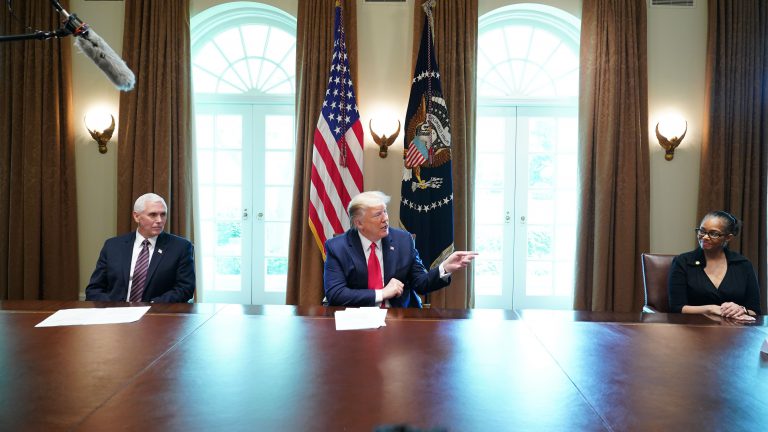Updated at 7:12 p.m. ET
The White House’s coronavirus response task force convened a briefing Tuesday afternoon at which President Trump promised a plan soon for post-disaster normalization.
Trump also has said he would be naming a number of people to serve on committees to advise him on when and how parts of the United States would open back up after going dormant to try to mitigate the spread of the virus.
The rundown of participants didn’t appear quite complete on Tuesday but Trump read off the names of a number of companies and CEOs he said might be involved; Trump also suggested he was waiting to hear back from some candidates.
The president also said he planned to speak on Thursday to all 50 governors about re-opening and, in his description, empower them to act as they see fit in terms of a strategy for normalization.
“I will then be authorizing each individual governor of each individual state to implement a reopening — and a very powerful opening plan — of their state at a time and in a manner as most appropriate,” Trump said.
Tuesday’s briefing followed a flap over whether Trump has the power to overrule governors on these kinds of decisions — or whether he has the power and might choose not to use it.
Ultimately, Trump said on Tuesday at an event ahead of the briefing that he would be working “with” governors after a few of them rejected his claims of authority.
Michigan Gov. Gretchen Whitmer, for example, a Democrat with whom Trump has sparred during the coronavirus disaster response, said that she would reserve for herself some of the key decisions about what is best for her state.
“We’re probably the best ones to be able to make a decision when it’s time to safely re-engage our economies,” she told NPR on Tuesday.
Groups of big East Coast and West Coast states announced on Monday they would decide by regional consensus about how to approach their strategies for normalcy given how closely they’re connected by metropolitan areas, transit and interdependent economies.
The briefing is underway now. Watch the briefing live here.
Trump appeared to try to reconcile all the recent tension over federalism on Tuesday by describing a model in which he uses the power he claims he has over the governors to authorize them to act on their own.
The federal government will continue to support the pandemic response, he said, and Trump hinted that he might try to authorize re-opening some states before May 1st, within the federally recommended time horizon for social distancing and other mitigation measures.
Some 20 states, Trump said, are in “extremely good shape,” suggesting they might be able to move on a timetable quicker than the worst afflicted metropolitan areas such as New York City.
Later in the briefing, however, Trump said that he might try to give himself a veto over the governors’ plans: “If we disagree with it, we’re not going to let them open,” he said.
Relief legislation unlikely this month
One announcement not expected at Tuesday’s briefing is about an agreement for more coronavirus relief legislation.
Talks appear frozen between Trump, Republicans and Democrats — led in the House by Speaker Nancy Pelosi — over the next round of assistance for an economy badly battered by the pandemic.
The House and the Senate both said on Tuesday they would not return until May 4, putting the earliest possible date for action on any legislation a few weeks away.
Trump and congressional leaders agree in principle on the need for more support for the economy but have struggled to get from that consensus to a nitty gritty agreement that can pass both houses of Congress.
Pelosi excoriated Trump in a letter to Democrats on Tuesday that blasted him in direct terms for lying to Americans about the coronavirus disaster and for what Pelosi called the weakness of the management of the response.
“The truth is because of an incompetent reaction to this health crisis, the strong economy handed to Donald Trump is now a disaster, causing the suffering of countless Americans and endangering lives,” Pelosi wrote. “The truth is a weak person, a poor leader, takes no responsibility. A weak person blames others.”
The speaker’s letter suggested that a gulf may remain for now between her and the administration in terms of negotiating another coronavirus bill.
Grudge renewed with World Health Org
Trump said on Tuesday he was directing what he called a “halt” to funding of the World Health Organization, which he has sought to blame for the scale of the coronavirus pandemic.
It wasn’t immediately clear what legal authority or legislation prevails in the case of U.S. funding for the W.H.O. or whether Trump has the unilateral power to direct the “halt.”
Sometimes when Congress appropriates funds it gives a president discretion over how they’re used; sometimes it does not. In the Ukraine affair last year, the Government Accountability Office concluded that Trump’s withholding of assistance for Kiev violated the law.
Trump’s budget proposal from earlier this year — a political document with no chance of passage in the Democratically controlled House — already proposed cuts to the W.H.O. and the Centers for Disease Control and Prevention.
The president said on Tuesday that during what he called the “halt,” his administration would conduct what he called a “review” of the U.S. relationship with the W.H.O.
In Trump’s telling, the international organization was too credulous of Chinese claims about the coronavirus in the early days of the outbreak and too critical of Trump’s decisions, including the restrictions he imposed on travel to the U.S. from China.
The United States is the biggest single source of funds for the W.H.O. and Trump said he worried about the value derived from those payments.
“With the outbreak of the COVID-19 pandemic we have deep concerns about whether America’s generosity has been put to the best use possible,” Trump said.
9(MDM5MjE5NTg1MDE1Mjk1MTM5NjlkMzI1ZQ000))

